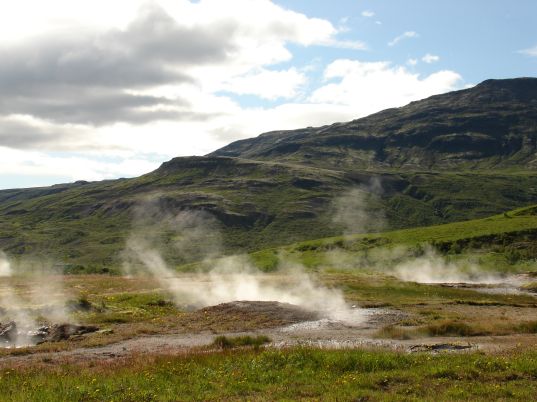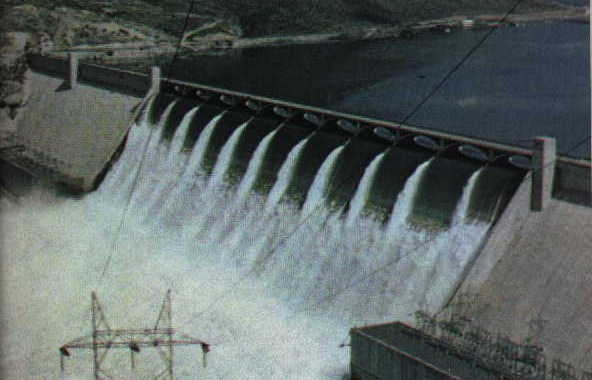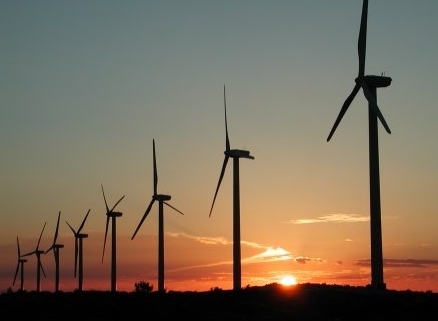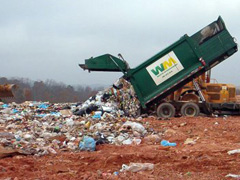





Solar energy, radiant light and heat from the sun, has been harnessed by humans since ancient times using a range of ever-evolving technologies. Solar radiation, along with secondary solar-powered resources such as wind and wave power, hydroelectricity and biomass, account for most of the available renewable energy on earth. Only a minuscule fraction of the available solar energy is used.
Solar powered electrical generation relies on heat engines and photovoltaics. Solar energy's uses are limited only by human ingenuity. A partial list of solar applications includes space heating and cooling through solar architecture, potable water via distillation and disinfection, daylighting, solar hot water, solar cooking, and high temperature process heat for industrial purposes.To harvest the solar energy, the most common way is to use solar panels.
Solar technologies are broadly characterized as either passive solar or active solar depending on the way they capture, convert and distribute solar energy. Active solar techniques include the use of photovoltaic panels and solar thermal collectors to harness the energy. Passive solar techniques include orienting a building to the Sun, selecting materials with favorable thermal mass or light dispersing properties, and designing spaces that naturally circulate air. The Earth receives 174 petawatts (PW) of incoming solar radiation (insolation) at the upper atmosphere.[1] Approximately 30% is reflected back to space while the rest is absorbed by clouds, oceans and land masses. The spectrum of solar light at the Earth's surface is mostly spread across the visible and near-infrared ranges with a small part in the near-ultraviolet.
Earth's land surface, oceans and atmosphere absorb solar radiation, and this raises their temperature. Warm air containing evaporated water from the oceans rises, causing atmospheric circulation or convection. When the air reaches a high altitude, where the temperature is low, water vapor condenses into clouds, which rain onto the Earth's surface, completing the water cycle.
Solar powered electrical generation relies on heat engines and photovoltaics. Solar energy's uses are limited only by human ingenuity. A partial list of solar applications includes space heating and cooling through solar architecture, potable water via distillation and disinfection, daylighting, solar hot water, solar cooking, and high temperature process heat for industrial purposes.To harvest the solar energy, the most common way is to use solar panels.
Solar technologies are broadly characterized as either passive solar or active solar depending on the way they capture, convert and distribute solar energy. Active solar techniques include the use of photovoltaic panels and solar thermal collectors to harness the energy. Passive solar techniques include orienting a building to the Sun, selecting materials with favorable thermal mass or light dispersing properties, and designing spaces that naturally circulate air. The Earth receives 174 petawatts (PW) of incoming solar radiation (insolation) at the upper atmosphere.[1] Approximately 30% is reflected back to space while the rest is absorbed by clouds, oceans and land masses. The spectrum of solar light at the Earth's surface is mostly spread across the visible and near-infrared ranges with a small part in the near-ultraviolet.
Earth's land surface, oceans and atmosphere absorb solar radiation, and this raises their temperature. Warm air containing evaporated water from the oceans rises, causing atmospheric circulation or convection. When the air reaches a high altitude, where the temperature is low, water vapor condenses into clouds, which rain onto the Earth's surface, completing the water cycle.
Wind power is the conversion of wind energy into a useful form of energy, such as using wind turbines to make electricity, wind mills for mechanical power, wind pumps for pumping water or drainage, or sails to propel ships.
At the end of 2009, worldwide nameplate capacity of wind-powered generators was 159.2 gigawatts (GW). Energy production was 340 TWh, which is about 2% of worldwide electricity usage; and has doubled in the past three years. Several countries have achieved relatively high levels of wind power penetration, such as 20% of stationary electricity production in Denmark, 14% in Ireland and Portugal, 11% in Spain, and 8% in Germany in 2009. As of May 2009, 80 countries around the world are using wind power on a commercial basis.
Large-scale wind farms are connected to the electric power transmission network; smaller facilities are used to provide electricity to isolated locations. Utility companies increasingly buy back surplus electricity produced by small domestic turbines. Wind energy, as an alternative to fossil fuels, is plentiful, renewable, widely distributed, clean, and produces no greenhouse gas emissions during operation. However, the construction of wind farms is not universally welcomed because of their visual impact but any effects on the environment are generally among the least problematic of any power source.
The intermittency of wind seldom creates problems when using wind power to supply a low proportion of total demand, but as the proportion rises, increased costs, a need to upgrade the grid, and a lowered ability to supplant conventional production may occur. Power management techniques such as exporting and importing power to neighboring areas or reducing demand when wind production is low, can mitigate these problems.
At the end of 2009, worldwide nameplate capacity of wind-powered generators was 159.2 gigawatts (GW). Energy production was 340 TWh, which is about 2% of worldwide electricity usage; and has doubled in the past three years. Several countries have achieved relatively high levels of wind power penetration, such as 20% of stationary electricity production in Denmark, 14% in Ireland and Portugal, 11% in Spain, and 8% in Germany in 2009. As of May 2009, 80 countries around the world are using wind power on a commercial basis.
Large-scale wind farms are connected to the electric power transmission network; smaller facilities are used to provide electricity to isolated locations. Utility companies increasingly buy back surplus electricity produced by small domestic turbines. Wind energy, as an alternative to fossil fuels, is plentiful, renewable, widely distributed, clean, and produces no greenhouse gas emissions during operation. However, the construction of wind farms is not universally welcomed because of their visual impact but any effects on the environment are generally among the least problematic of any power source.
The intermittency of wind seldom creates problems when using wind power to supply a low proportion of total demand, but as the proportion rises, increased costs, a need to upgrade the grid, and a lowered ability to supplant conventional production may occur. Power management techniques such as exporting and importing power to neighboring areas or reducing demand when wind production is low, can mitigate these problems.
Geothermal energy is thermal energy generated and stored in the Earth. Thermal energy is energy that determines the temperature of matter. Earth's geothermal energy originates from the original formation of the planet, from radioactive decay of minerals, from volcanic activity, and from solar energy absorbed at the surface. The geothermal gradient, which is the difference in temperature between the core of the planet and its surface, drives a continuous conduction of thermal energy in the form of heat from the core to the surface.
From hot springs, geothermal energy has been used for bathing since Paleolithic times and for space heating since ancient Roman times, but it is now better known for electricity generation. Worldwide, about 10,715 megawatts (MW) of geothermal power is online in 24 countries. An additional 28 gigawatts of direct geothermal heating capacity is installed for district heating, space heating, spas, industrial processes, desalination and agricultural applications
Geothermal power is cost effective, reliable, sustainable, and environmentally friendly, but has historically been limited to areas near tectonic plate boundaries. Recent technological advances have dramatically expanded the range and size of viable resources, especially for applications such as home heating, opening a potential for widespread exploitation. Geothermal wells release greenhouse gases trapped deep within the earth, but these emissions are much lower per energy unit than those of fossil fuels. As a result, geothermal power has the potential to help mitigate global warming if widely deployed in place of fossil fuels.
The Earth's geothermal resources are theoretically more than adequate to supply humanity's energy needs, but only a very small fraction may be profitably exploited. Drilling and exploration for deep resources is very expensive.[citation needed] Forecasts for the future of geothermal power depend on assumptions about technology, energy prices, subsidies, and interest rates.
From hot springs, geothermal energy has been used for bathing since Paleolithic times and for space heating since ancient Roman times, but it is now better known for electricity generation. Worldwide, about 10,715 megawatts (MW) of geothermal power is online in 24 countries. An additional 28 gigawatts of direct geothermal heating capacity is installed for district heating, space heating, spas, industrial processes, desalination and agricultural applications
Geothermal power is cost effective, reliable, sustainable, and environmentally friendly, but has historically been limited to areas near tectonic plate boundaries. Recent technological advances have dramatically expanded the range and size of viable resources, especially for applications such as home heating, opening a potential for widespread exploitation. Geothermal wells release greenhouse gases trapped deep within the earth, but these emissions are much lower per energy unit than those of fossil fuels. As a result, geothermal power has the potential to help mitigate global warming if widely deployed in place of fossil fuels.
The Earth's geothermal resources are theoretically more than adequate to supply humanity's energy needs, but only a very small fraction may be profitably exploited. Drilling and exploration for deep resources is very expensive.[citation needed] Forecasts for the future of geothermal power depend on assumptions about technology, energy prices, subsidies, and interest rates.
Waste-to-energy (WtE) or energy-from-waste (EfW) is the process of creating energy in the form of electricity or heat from the incineration of waste source. WtE is a form of energy recovery. Most WtE processes produce electricity directly through combustion, or produce a combustible fuel commodity, such as methane, methanol, ethanol or synthetic fuels.
There are a number of other new and emerging technologies that are able to produce energy from waste and other fuels without direct combustion. Many of these technologies have the potential to produce more electric power from the same amount of fuel than would be possible by direct combustion. This is mainly due to the separation of corrosive components (ash) from the converted fuel, thereby allowing higher combustion temperatures in e.g. boilers, gas turbines, internal combustion engines, fuel cells.
Thermal technologies:
* Gasification (produces combustible gas, hydrogen, synthetic fuels)
* Thermal depolymerization (produces synthetic crude oil, which can be further refined)
* Pyrolysis (produces combustible tar/biooil and chars)
* Plasma arc gasification PGP or plasma gasification process (produces rich syngas including hydrogen and carbon monoxide usable for fuel cells or generating electricity to drive the plasma arch, usable vitrified silicate and metal ingots, salt and sulphur)
Non-thermal technologies:
* Anaerobic digestion (Biogas rich in methane)
* Fermentation production (examples are ethanol, lactic acid, hydrogen)
* Mechanical biological treatment (MBT)
o MBT + Anaerobic digestion
o MBT to Refuse derived fuel
There are a number of other new and emerging technologies that are able to produce energy from waste and other fuels without direct combustion. Many of these technologies have the potential to produce more electric power from the same amount of fuel than would be possible by direct combustion. This is mainly due to the separation of corrosive components (ash) from the converted fuel, thereby allowing higher combustion temperatures in e.g. boilers, gas turbines, internal combustion engines, fuel cells.
Thermal technologies:
* Gasification (produces combustible gas, hydrogen, synthetic fuels)
* Thermal depolymerization (produces synthetic crude oil, which can be further refined)
* Pyrolysis (produces combustible tar/biooil and chars)
* Plasma arc gasification PGP or plasma gasification process (produces rich syngas including hydrogen and carbon monoxide usable for fuel cells or generating electricity to drive the plasma arch, usable vitrified silicate and metal ingots, salt and sulphur)
Non-thermal technologies:
* Anaerobic digestion (Biogas rich in methane)
* Fermentation production (examples are ethanol, lactic acid, hydrogen)
* Mechanical biological treatment (MBT)
o MBT + Anaerobic digestion
o MBT to Refuse derived fuel
Hydropower, hydraulic power or water power is power that is derived from the force or energy of moving water, which may be harnessed for useful purposes. Prior to the widespread availability of commercial electric power, hydropower was used for irrigation, and operation of various machines, such as watermills, textile machines, sawmills, dock cranes, and domestic lifts. Another method used a trompe to produce compressed air from falling water, which could then be used to power other machinery at a distance from the water.
In hydrology, hydropower is manifested in the force of the water on the riverbed and banks of a river. It is particularly powerful when the river is in flood. The force of the water results in the removal of sediment and other materials from the riverbed and banks of the river, causing erosion and other alterations.
Hydropower has been used for hundreds of years. In India, water wheels and watermills were built; in Imperial Rome, water powered mills produced flour from grain, and were also used for sawing timber and stone; in China, watermills were widely used since the Han Dynasty. The power of a wave of water released from a tank was used for extraction of metal ores in a method known as hushing. The method was first used at the Dolaucothi gold mine in Wales from 75 AD onwards, but had been developed in Spain at such mines as Las Medulas. Hushing was also widely used in Britain in the Medieval and later periods to extract lead and tin ores. It later evolved into hydraulic mining when used during the California gold rush.
In hydrology, hydropower is manifested in the force of the water on the riverbed and banks of a river. It is particularly powerful when the river is in flood. The force of the water results in the removal of sediment and other materials from the riverbed and banks of the river, causing erosion and other alterations.
Hydropower has been used for hundreds of years. In India, water wheels and watermills were built; in Imperial Rome, water powered mills produced flour from grain, and were also used for sawing timber and stone; in China, watermills were widely used since the Han Dynasty. The power of a wave of water released from a tank was used for extraction of metal ores in a method known as hushing. The method was first used at the Dolaucothi gold mine in Wales from 75 AD onwards, but had been developed in Spain at such mines as Las Medulas. Hushing was also widely used in Britain in the Medieval and later periods to extract lead and tin ores. It later evolved into hydraulic mining when used during the California gold rush.


Waste management is the collection, transport, processing, recycling or disposal, and monitoring of waste materials. The term usually relates to materials produced by human activity, and is generally undertaken to reduce their effect on health, the environment or aesthetics. Waste management is also carried out to recover resources from it. Waste management can involve solid, liquid, gaseous or radioactive substances, with different methods and fields of expertise for each.
Waste management practices differ for developed and developing nations, for urban and rural areas, and for residential and industrial producers. Management for non-hazardous waste residential and institutional waste in metropolitan areas is usually the responsibility of local government authorities, while management for non-hazardous commercial and industrial waste is usually the responsibility of the generator.
Integrated waste management using LCA (life cycle analysis) attempts to offer the most benign options for waste management. For mixed MSW (Municipal Solid Waste) a number of broad studies have indicated that waste administration, then source separation and collection followed by reuse and recycling of the non-organic fraction and energy and compost/fertilizer production of the organic waste fraction via anaerobic digestion to be the favoured path. Non-metallic waste resources are not destroyed as with incineration, and can be reused/ recycled in a future resource depleted society.
The management of waste is a key component in a business' ability to maintaining ISO14001 accreditation. Companies are encouraged to improve their environmental efficiencies each year. One way to do this is by improving a company’s waste management with a new recycling service. (such as recycling: glass, food waste, paper and cardboard, plastic bottles etc.)
Waste management practices differ for developed and developing nations, for urban and rural areas, and for residential and industrial producers. Management for non-hazardous waste residential and institutional waste in metropolitan areas is usually the responsibility of local government authorities, while management for non-hazardous commercial and industrial waste is usually the responsibility of the generator.
Integrated waste management using LCA (life cycle analysis) attempts to offer the most benign options for waste management. For mixed MSW (Municipal Solid Waste) a number of broad studies have indicated that waste administration, then source separation and collection followed by reuse and recycling of the non-organic fraction and energy and compost/fertilizer production of the organic waste fraction via anaerobic digestion to be the favoured path. Non-metallic waste resources are not destroyed as with incineration, and can be reused/ recycled in a future resource depleted society.
The management of waste is a key component in a business' ability to maintaining ISO14001 accreditation. Companies are encouraged to improve their environmental efficiencies each year. One way to do this is by improving a company’s waste management with a new recycling service. (such as recycling: glass, food waste, paper and cardboard, plastic bottles etc.)





- Home
- Esoteric
- Environmental Awareness
- Ashram
- Lotus Water Lily
- Rose
- Rare Herbal Plants
- Child & Women Empowerment
- Services
- New & Renewable Energy
- Video Gallery
- Members
- Contact Us
